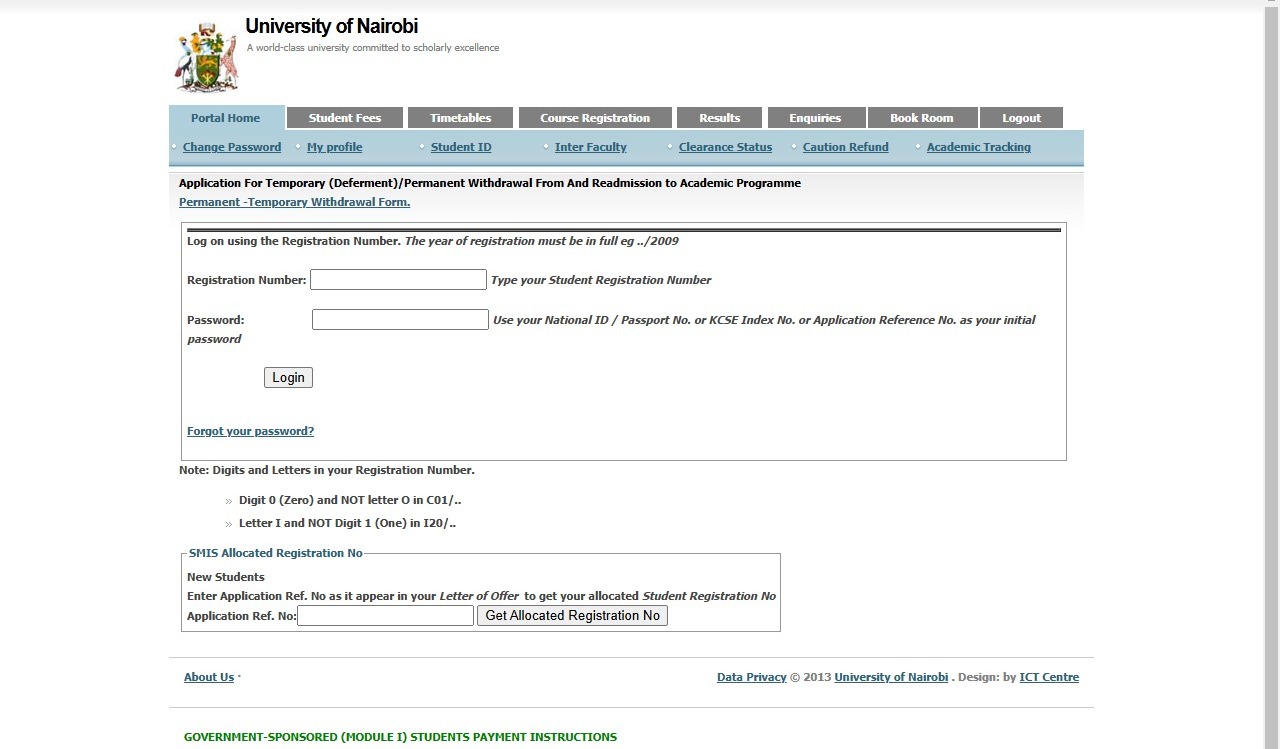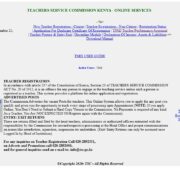
Smis Uonbi Problems? 5 Easy Fixes for Students
The Role of SMIS UONBI in Transforming Data Management in Kenyan Education
The world of education is evolving rapidly, and institutions in Kenya like the University of Nairobi Business Innovation (UONBI) are at the forefront of this transformation. One significant aspect of this change is the implementation of the Student Management Information System (SMIS), which plays a crucial role in enhancing data management across various levels of education.
SMIS is designed to streamline processes related to student data. It collects, manages, and disseminates student-related information efficiently. This ensures that administrative operations within universities, especially UONBI, become more effective. By utilizing SMIS, institutions can reduce paperwork, minimize errors, and expedite processes, making education administration more efficient overall.
Benefits of SMIS in Kenyan Education
- Efficient Data Management: SMIS allows for centralized data storage, facilitating easy access and retrieval of student information. This efficiency supports the quick generation of reports and data analysis.
- Improved Communication: The system enhances communication between students, faculty, and administration. Students can easily access their grades, schedules, and other pertinent information online.
- Support Decision-Making: With accurate data at their fingertips, administrators can make informed decisions about course offerings, resource allocation, and the overall management of the institution.
- User-Friendly Interface: The SMIS system is designed to be user-friendly, ensuring that students and staff with varying tech-savvy levels can navigate it without difficulties.
At UONBI, the integration of SMIS is particularly notable. As one of Kenya’s leading universities, UONBI aims to enhance its educational delivery. The system is tailored to cater to the unique needs of its diverse student body. For instance, SMIS supports tracking academic progression, managing financial aid, and even addressing student queries.
Data Security and Privacy
One of the most pressing concerns in data management is security. The implementation of SMIS at UONBI includes robust security measures to safeguard sensitive student information. Regular audits and updates ensure that data is protected against unauthorized access. UONBI understands the necessity of maintaining trust with its students and their families.
Impact on Student Experience
SMIS has profoundly affected the student experience at UONBI. Students now have the ability to:
- Check academic results quickly and at their convenience.
- Monitor their academic progress with personalized dashboards.
- Access administrative support without long waiting times.
This digital transformation leads to a more engaged student body, as they feel empowered to take charge of their academic journey.
Challenges Faced
Despite the advantages, the implementation of SMIS is not without challenges. Some common issues faced include:
- Training Needs: Not all staff may be familiar with the new system, necessitating comprehensive training sessions.
- Resistance to Change: Some individuals may be hesitant to transition from traditional paper-based systems to digital solutions.
- Technical Glitches: As with any software, technical issues can arise, necessitating ongoing support and maintenance.
UONBI continues to address these challenges through training programs, workshops, and enhancing the technical infrastructure to reduce downtime.
Future Prospects
Looking ahead, UONBI aims to expand the capabilities of SMIS further. Future developments may include:
Get Money fast with ZangCash Pay in Kenya! Get Money to Pay Bills, Rent, Fees, Shopping and more—Apply now for the support you need via Mpesa
- Integration with other educational technology platforms to provide a holistic educational experience.
- Additional features like mobile access for students, allowing even greater flexibility in how they access information.
- The use of data analytics to predict student performance and personalize their educational paths.
As UONBI enhances its digital offerings, it sets a precedent for other educational institutions across Kenya to follow suit.
For more information on SMIS and registration and login, you may explore the following:
SMIS at UONBI is not just a system for managing student information; it is a transformative tool that redefines the educational framework. By optimizing data management, enhancing user experience, and addressing challenges head-on, UONBI is leading the way in modernizing education in Kenya.
Benefits of Integrating SMIS for Enhanced Student Experience at UONBI
The digital transformation in educational institutions is reshaping the student experience, and integrating a Student Management Information System (SMIS) presents tremendous advantages for students at the University of Nairobi (UONBI). Such systems streamline numerous academic processes, thereby enhancing various aspects of student life. Here, we will explore how SMIS can benefit UONBI students.
Streamlined Academic Administration
One of the primary benefits of SMIS is the automation of administrative processes. This system allows students to:
- Register for classes easily without long queues.
- Check their academic performance through real-time updates.
- Receive important announcements related to schedules or changes in their courses.
This level of convenience minimizes frustrations and helps students focus more on their studies rather than administrative hurdles.
Enhanced Communication
Communication between students and faculty members is crucial for a successful academic journey. An integrated SMIS fosters this interaction by providing:
- Email notifications to keep students informed about essential updates.
- Direct messaging systems that allow students to reach out to professors with ease.
- An online forum for discussion, enabling peer-to-peer and student-faculty engagement.
This close-knit communication network promotes a collaborative learning environment conducive to academic success.
Access to Comprehensive Resources
UONBI students can greatly benefit from the extensive resources integrated within an SMIS, including:
Get Money fast with ZangCash Pay in Kenya! Get Money to Pay Bills, Rent, Fees, Shopping and more—Apply now for the support you need via Mpesa
- Digital libraries with access to a wide range of academic resources.
- Online enrollment in co-curricular and extracurricular activities.
- Resource allocation for various departmental needs, streamlining the material acquisition process.
Easier access to academic resources enhances the overall educational experience and allows students to tap into various learning supports.
Data-Driven Insights for Better Decision-Making
Another compelling advantage of integrating SMIS at UONBI is the capability to harness data for informed decision-making. The system can track valuable insights such as:
| Data Type | Purpose |
|---|---|
| Student Performance Data | Identify struggling students and provide timely interventions. |
| Course Enrollment Trends | Assist in assessing which courses are popular, leading to better resource allocation. |
| Feedback Mechanisms | Improve services based on student feedback and data. |
These insights empower the administration to tailor programs and services to meet students’ evolving needs effectively.
Improved Financial Management
Financial matters can be overwhelming for many students. An SMIS allows for seamless management of:
- Tuition payments and tracking.
- Financial aid applications and disbursements.
- Access to scholarship opportunities and necessary documentation.
This integration alleviates the financial burden and provides transparency in financial dealings, enabling students to make informed decisions regarding their educational investments.
Flexible Learning Opportunities
In today’s dynamic educational landscape, flexibility is key. An SMIS enables UONBI to offer:
- Online courses that cater to diverse learning needs.
- Hybrid learning options combining traditional and digital modalities.
- Access to recorded lectures and materials for students who may have missed classes.
This flexibility accommodates various lifestyles and increases educational accessibility, allowing students to thrive academically.
By integrating SMIS at UONBI, students can enjoy a more organized, communicative, and resourceful learning environment. The focus on data-driven decisions also ensures that every program aligns with students’ needs and enhances their overall experience. For more information about SMIS and its implementation in universities, you can refer to the University of Nairobi’s official website and other related resources like Kenya’s Ministry of Education.
Bridging the Gap: How SMIS at UONBI Supports Remote and Online Learning
As educational institutions adapt to the evolving landscape of learning, the University of Nairobi (UONBI) has emerged as a leader in leveraging technology to support students. A vital tool in this transformation is the Student Management Information System (SMIS). SMIS is instrumental in enhancing remote and online learning, providing students with accessibility and convenience.
Get Money fast with ZangCash Pay in Kenya! Get Money to Pay Bills, Rent, Fees, Shopping and more—Apply now for the support you need via Mpesa
Through the implementation of SMIS, UONBI is able to address several key areas that significantly enhance the educational experience for both students and faculty. Here’s how it bridges the educational gap:
- Centralized Information Access: SMIS consolidates all critical academic information in one central location. Students can access course materials, grades, and announcements anytime, from anywhere.
- Enhanced Communication: The system facilitates effective communication between students and instructors. With features like messaging and discussion forums, students can ask questions and engage in discussions without needing to be on campus.
- Streamlined Administrative Processes: SMIS simplifies administrative tasks, such as course registration and grading. This efficiency allows academic staff to focus more on teaching and interacting with students.
- Tracking Academic Progress: Students can monitor their academic performance through the system. This feature encourages self-paced learning, enabling students to identify areas they need to improve.
One of the standout features of SMIS is its user-friendly interface. This accessibility lowers barriers for students who might not be technologically savvy. As long as you have a reliable internet connection, engaging with course content becomes a seamless experience. This is particularly important in Kenya, where internet penetration continues to improve but may still pose challenges in some regions.
Moreover, the adaptability of SMIS means that it can be accessed via various devices—be it a computer, tablet, or smartphone. This flexibility is crucial for students who may not have consistent access to a single device. The mobile-friendly design ensures that learning can happen on the go, enabling students to balance their studies with other obligations.
In addition to facilitating current students, SMIS also provides valuable resources for prospective students. By offering detailed information about available courses and programs, as well as the admission process, UONBI can effectively attract a broader audience. This, in turn, aids in expanding the university’s reach across Kenya and beyond.
While online learning offers many advantages, it can also come with challenges. One notable challenge is the risk of students feeling isolated in a virtual environment. To combat this, UONBI encourages collaborative learning opportunities through SMIS. Here are a few initiatives supported by the system:
- Group Projects: SMIS allows students to collaborate on assignments and projects easily. Working in groups fosters community and helps students feel more connected.
- Virtual Study Sessions: The system supports scheduling of virtual meetings, where students can discuss course materials and help each other prepare for exams.
- Workshops and Webinars: UONBI frequently organizes online events that students can join to enhance their learning experience and engage with faculty and industry professionals.
Ultimately, the effectiveness of SMIS in supporting remote and online learning at UONBI lies in how it facilitates interaction and connection among students and faculty. It positions the university as a forward-thinking institution that prioritizes student engagement and success in a digital age.
Furthermore, the continuous improvement of SMIS is a testament to UONBI’s commitment to bettering the student experience. Regular updates and feedback mechanisms ensure that the system evolves based on the needs of its users. Such dedication makes UONBI a model for other institutions aiming to enhance their remote learning capabilities.
Students interested in learning more about UONBI and its offerings can visit the official website at www.uonbi.ac.ke.
Challenges and Opportunities in Implementing SMIS at Kenyan Universities
In recent years, universities in Kenya have turned towards the implementation of Student Management Information Systems (SMIS) to improve administrative efficiency and enhance the student experience. However, this shift is not without its challenges and opportunities. Understanding these elements can help institutions better navigate the complexities of adopting such systems.
Get Money fast with ZangCash Pay in Kenya! Get Money to Pay Bills, Rent, Fees, Shopping and more—Apply now for the support you need via Mpesa
Challenges in Implementing SMIS
Despite the promising advantages, several challenges hinder the successful implementation of SMIS in Kenyan universities:
- Resistance to Change: Many faculty and staff members are accustomed to traditional methods of operation. This cultural resistance can impede the transition to a more automated system.
- Inadequate Infrastructure: Some institutions face technological hurdles, including outdated hardware and limited internet connectivity, which can complicate the implementation process.
- Training and Support: Proper training is essential for staff and students. Without adequate training sessions, users may struggle with the system, leading to frustration and resistance.
- Data Privacy Concerns: The management of sensitive student information raises concerns about data security. Institutions must prioritize data protection to maintain trust.
- Cost of Implementation: Initial investment costs for software, hardware, and training can be substantial, posing a significant barrier for some institutions.
Potential Solutions to Overcome Challenges
To address these hurdles, universities can take several steps:
- Change Management Programs: Implement structured change management initiatives to ease the transition. Engaging staff early in the process can foster a more positive outlook.
- Invest in Infrastructure: Upgrading technological resources to meet the requirements for SMIS can pave the way for smoother implementation.
- Comprehensive Training: Offering extensive training sessions, both in-person and online, will help familiarize users with the system.
- Strengthening Data Security: Institutions must invest in robust cybersecurity measures to safeguard student data.
- Phased Implementation: Instead of a full-scale launch, a phased approach can help universities adapt and refine the system gradually.
Opportunities Presented by SMIS
On the other hand, implementing SMIS offers various opportunities that can benefit Kenyan universities significantly:
- Enhanced Efficiency: SMIS automates administrative tasks such as registration, scheduling, and record-keeping, reducing manual errors and saving time.
- Improved Student Engagement: A centralized system allows for better communication between students and administration, thus fostering an engaged academic community.
- Data-Driven Decision Making: SMIS can generate valuable insights and reports, helping administrators make informed decisions based on real-time data.
- Streamlined Processes: Automated processes help universities handle large volumes of students more effectively, making it easier to track performance and progression.
- Global Standards: Adopting SMIS aligns Kenyan universities with international academic practices, improving their standing in global education.
Case Studies and Best Practices
Several Kenyan universities have successfully implemented SMIS, overcoming challenges and reaping rewards. For example:
| University | Year Implemented | Key Benefits |
|---|---|---|
| University of Nairobi (UoN) | 2019 | Streamlined registration, enhanced student services |
| Kenya Methodist University (KeMU) | 2020 | Improved communication channels, data analytics for decision making |
| Strathmore University (Strathmore) | 2021 | Reduced administrative burden, better tracking of student progress |
The above examples highlight the transformative effect of SMIS on university operations. By learning from these institutions, others can find tailored solutions that fit their unique challenges and capitalize on emerging opportunities. Collaborating with tech developers and engaging with stakeholders will play a crucial role in optimizing SMIS applications in the academic landscape.
As the academic sector in Kenya continues to evolve, embracing SMIS is not just an option; it is becoming vital to stay competitive and provide students with the best possible education experience.
Future Trends: The Evolution of SMIS and Its Impact on Higher Education in Kenya
The landscape of higher education in Kenya is rapidly transforming, driven largely by advancements in Student Management Information Systems (SMIS). These systems are becoming essential tools for universities, colleges, and other educational institutions as they navigate the challenges of modern education. As we look to the future, the evolution of SMIS is poised to significantly impact how educational institutions function, interact with students, and manage their resources.
As educational institutions adapt to these changes, several trends in SMIS are emerging as key drivers of this transformation:
- Integration with Learning Management Systems (LMS): Many educational institutions are integrating SMIS with LMS platforms. This synergy enhances the learning experience by allowing for more effective tracking of student performance and engagement.
- Data Analytics: The use of data analytics within SMIS enables institutions to offer personalized learning experiences. Analyzing student data can help in identifying areas where learners struggle and providing targeted support.
- Mobile Accessibility: With the rise of mobile technology, access to SMIS through smartphones and tablets is becoming critical. This mobility ensures that students can manage their academic information anytime, anywhere, promoting engagement and convenience.
- Cloud-Based Solutions: Cloud technology offers scalable and cost-effective SMIS solutions. Institutions are increasingly turning to cloud-based systems that reduce the need for on-site IT infrastructure and allow for easy updates.
These trends reflect a focus on improving administrative processes and enhancing the student experience. With a growing number of students enroling in universities across Kenya, effective SMIS is crucial for managing student data and streamlining operations.
Get Money fast with ZangCash Pay in Kenya! Get Money to Pay Bills, Rent, Fees, Shopping and more—Apply now for the support you need via Mpesa
Many universities are adopting SMIS to handle various critical operations, such as:
| Operation | Description |
|---|---|
| Student Enrolment | Facilitates the registration process, ensuring a seamless experience for new students. |
| Course Management | Allows for real-time updates to course offerings, schedules, and requirements. |
| Financial Management | Streamlines tuition payment processes and tracks financial aid distribution. |
The adoption of SMIS in higher education institutions in Kenya results in improved efficiency and increased student satisfaction. Beyond streamlining administration, an effective SMIS fosters better communication between students and faculty, enhancing the overall academic environment.
As the technology surrounding SMIS continues to advance, several challenges must be addressed. Data privacy remains a significant concern as educational institutions collect vast amounts of sensitive information. Institutions must prioritize the implementation of robust cybersecurity measures to protect student data against breaches.
Another challenge is training staff and students to effectively utilize new systems. As institutions upgrade their SMIS, providing adequate training and ongoing support is essential to ensure everyone benefits from these advancements.
Looking ahead, the future of SMIS in Kenya’s higher education system looks promising. With a focus on innovation and user engagement, education providers can significantly impact student success and institutional effectiveness.
Schools now more than ever should harness the potential of SMIS not just as a tool for administration, but as a foundational element for a more responsive and student-centered educational environment. As educational stakeholders embrace change, they pave the way for a brighter, more accessible future in learning.
For more insights on SMIS and its role in education, you can visit University World News or explore resources at International University of Management.
Key Takeaway:
The implementation of Student Management Information Systems (SMIS) at the University of Nairobi (UONBI) is a transformative step that enhances the educational landscape in Kenya. A key takeaway from the analysis of SMIS is its pivotal role in reshaping how data management operates within academic institutions. By efficiently organizing student information, academic records, and administrative data, UONBI has established a centralized system that not only streamlines operations but also improves accessibility to important information for both students and staff.
The integration of SMIS directly impacts the student experience by simplifying processes such as course registration, grades access, and communication with faculty members. Students can now easily access real-time information, fostering a more proactive approach to their academic journey. This immediate access enhances their learning experience, enabling them to focus more on their studies rather than getting bogged down with bureaucratic hurdles.
Get Money fast with ZangCash Pay in Kenya! Get Money to Pay Bills, Rent, Fees, Shopping and more—Apply now for the support you need via Mpesa
Moreover, SMIS plays a crucial role in supporting remote and online learning, which has become increasingly essential in today’s educational climate. By providing a robust platform for managing virtual classrooms, UONBI can effectively bridge the gap for students who may not be able to attend in-person classes. This ensures that quality education remains accessible to all, regardless of geographical barriers or personal circumstances.
However, the journey of implementing SMIS is not without its challenges. Institutions face hurdles such as limited funding, the need for ongoing training, and resistance to change among staff and students. Yet, these challenges also present opportunities for growth and improvement. By addressing these issues, UONBI can lead the way in establishing a new standard for higher education in Kenya, positioning itself as a model for other universities.
Looking ahead, the future of SMIS promises to evolve with technological advancements, potentially integrating artificial intelligence and big data analytics to further enhance teaching and learning experiences. As the educational landscape in Kenya continues to grow, the effective implementation and adaptation of SMIS at UONBI will significantly influence the overall progress of higher education in the country. By embracing these changes, UONBI not only uplifts its own academic community but also contributes to the broader educational framework in Kenya, making it a vital player in the advancement of education and technology.
Conclusion
The implementation of the Student Management Information System (SMIS) at the University of Nairobi (UONBI) represents a pivotal shift in how data is utilized within Kenyan education. By streamlining data management, UONBI is enhancing operational efficiency and ultimately enriching the academic journey for students. With an integrated SMIS, students benefit from a more personalized educational experience, where access to vital information is seamless and user-friendly. This fosters greater engagement and satisfaction among students, setting a higher standard of educational support.
Furthermore, SMIS plays a crucial role in bridging the gap for remote and online learning. It ensures that students, regardless of their geographical locations, can access resources, course materials, and communication tools. This accessibility is especially important in a country where digital divide challenges still exist. UONBI’s strategic approach to implementing SMIS also highlights the array of challenges faced during deployment, such as ensuring staff training and technology infrastructure. Yet, these challenges present opportunities for growth, encouraging continuous improvement and adaptation in the ever-evolving educational landscape.
Looking ahead, the future of SMIS in higher education in Kenya appears promising. As technology continues to advance, so too will the capabilities of systems like SMIS, enabling more robust analytics, enhanced security features, and improved user interfaces. This evolution will not only strengthen the quality of education but also contribute significantly to the broader goals of educational reform in the country. With ongoing investment and focus on these systems, UONBI and other Kenyan universities can pave the way for a more innovative, accessible, and effective educational experience for all students.





